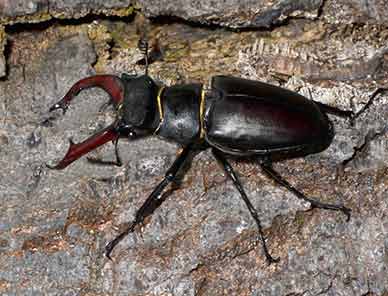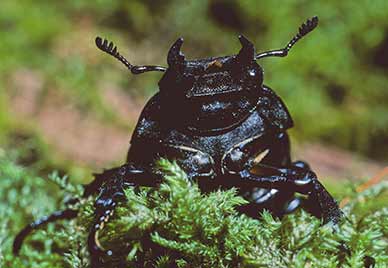Stag beetles (Lucanus cervus)
When: May to August
How many:
Relatively widespread and abundant

(image courtesy of Paul Brock)
The New Forest is a stronghold for the nationally scarce stag beetle, but these quite large creatures are unlikely to be encountered during a day-time walk. Stag beetles are, however, quite often seen around the towns and villages on warm, early to mid-summer evenings.
Elsewhere in Britain, stag beetle numbers have substantially reduced, partially, it’s thought, because the rotting wood on which they depend is no longer so readily available in our ever-tidier gardens and countryside. Indeed, stag beetle distribution is now largely restricted to the south of England, and even then is further limited to South Hampshire, West Sussex; North Essex and the Thames Valley.
But in the New Forest, stag beetles remain relatively abundant, living out their early lives in the open, unenclosed woodlands where broad-leaved trees are left to live their natural span before eventually decaying, dying and returning to the soil.
Stag beetles are fairly easy to recognise.
Males have a shiny black head and thorax – the bit behind the head - and reddish-brown wing cases. They measure between 3.5 and 7.5 centimetres (almost 1 ½ - 3 inches), including their implausibly large mandibles that can account for almost half their length.
Somewhat fancifully likened to the antlers of red deer stags, the mandibles are used in battles between rivals and during courtship posturing. Thankfully, however, they are not used to bite humans.
Females are not quite so big, have darker overall colouration, significantly smaller, but much sharper mandibles, and are more inclined to bite – it’s never wise to pick one up!

looking creatures, too
Warm weather from mid-May onwards encourages stag beetle emergence, the time when adult males take to the wing in search of the slightly later-emerging females. Both feed on tree sap, which is lapped up with their long, yellow tongues.
Battles between rival males are frequent, and it’s then that the antlers come into play, used as fearsome weapons as each tries to defeat the other. These fights, however, like those of their namesakes, the red deer, are most often trials of strength that infrequently result in serious injury.
After mating, females lay their eggs in rotting wood – log piles, tree trunks and fence posts are favourite sites. Few, if any, adults survive much beyond the end of August.
During the three to five year larval stage, stag beetles live in, and feed on, the rotting wood. Strange-looking creatures, larvae are plump, bulbous, wrinkly, creamy-white, six-legged beasts with orangey-brown heads and jaws designed for tearing and chewing.
When ready to pupate, the larvae leave their wooden home and move underground, forming around themselves for protection an often sizeable cocoon. Adult beetles emerge from the cocoons in autumn, but remain underground until ready to fly in the following spring.
References:
Collins Guide to the Insects of Britain and Western Europe: Michael Chinery
Insects of Britain and Europe: J. Zahradnik and M. Chvala
More links
Other related links
Search this site

Sadly, 58 animals were killed - 35 ponies, 13 cows, 8 donkeys and 2 sheep, whilst a further 32 were injured - 3 pigs, 9 donkeys, 11 cows and 9 ponies.
(Forty-three accidents occurred in daylight, 15 at twilight and 101 in the dark. Twenty-seven accidents were not reported by the driver involved).
Here's just one horrific example - Three donkeys killed in collision with van at notorious New Forest blackspot (Advertiser and Times)

